Education needs to be provided to all females if we want to improve the status of females in society. Educated women will help in the socio-economic development of the country. Education is a good instrument to remove the disparities that all women face within and outside their families. Education provides a platform for women’s empowerment, prosperity, and welfare. This paper tries to capture the significance of women’s education, the problem faced in educating women, causes of low literacy among females, women’s participation, steps taken by the government for promoting women’s education, merits, and recommendations for promoting women’s education.
Role of Education in the Empowerment of Women in India
Women had access to education in India during the Vedic era. But women had lost their rights gradually. But in the British time, the education of women attained thrust in India. Many socioreligious movements undertaken by famous personas like R. R. M. Roy, I. C. Vidyasagar emphasized the education of women in India. Many initiatives were taken by leaders who belonged to the lower castes (M. Phule, Periyar, and B. R. Ambedkar) for promoting the education of women. After the Independence of India in 1947, the education of women got priority and many steps were taken by the government to promote and to provide and make accessible education for all women.
1. Introduction:
The term empowerment focuses on framing an environment in which one can take decisions and make choices either independently or on a collective basis for undertaking social transformation without any bias and pressures from outside agencies or authorities. Empowerment raises the capacity to attain rational thinking, authority, and training (Hashemi Schuler and Riley, 1996). It is a methodology of authorizing people to think, take action and autonomously control the activities. There are innumerable sections in the society that are deprived of even their basic rights and these sections lack awareness of their rights. Women top in this row. Women are the basis of the very existence of human beings. Everybody is well-known about this fact but nobody tries to accept this fact.
Due to this male hypocrisy or male-dominated society, the importance of women is falling continuously in the present scenario. Unfortunately, women take a backseat in society and deprive themselves of even their basic rights. That calls for a need for the empowerment of women. Women’s empowerment has taken an important place in international conferences and national talks. There is a need to rethink and reframe the definition of freedom and empowerment. We genuinely need to think about whether every citizen of the country is enjoying freedom. Is the definition of freedom different on a gender basis? The inequalities between males and females and discrimination against females are age-old customs all over the globe. The quest for equality of women with men is a universal concept. Women must be ensured with equal and fair opportunities just like men in terms of education, jobs, inheritance, marriage, and politics, etc. Their pursuit for equality has promoted to focus on women and movements. The Constitution of our country doesn’t discriminate between men and women, but our society has deprived women of certain basic rights, which were already provided by our Constitution. Empowerment gives individuals to utilize their full potential, improve their political and social participation, and believe in their capabilities.
Women’s economic contribution is now being analyzed by development agencies, academicians, professionals, and professional organizations everywhere in the world. Along with several other analyses and assumptions, if women achieve their highest economic potential, economic growth will be quadrupled, as might changes in social conventions and stereotypes that affect women’s well-being. As said by McKinsey and Company, if women had the same economic incentives, skills, opportunities, and accessibility as males, worldwide Gross Domestic Product (GDP) would grow by up to 26% by 2025. As per Food and Agriculture Organization, when male and female farmers have equal accessibility, yields can grow by 20 to 30 percent, providing maximum agricultural output in emerging economies by 2.5 to 4%, and dropping the food insecurity rate by 12 to 17 percent.
Women’s active engagement in the Indian economy can add US$700 billion to GDP by 2025, create 50 to 60 million jobs through female and/or based enterprises by 2030, and improve health and education outcomes for families, given that they budget 90% of their income on with their families. Women’s socio-economic status, choice, and negotiating power will boost intra and multi socio-economic status, as well as have a beneficial intergenerational influence on health and education, once they have equal rights and opportunities within the economy. Women’s economic emancipation (WEE) has become a vital part of women’s rights, productivity expansion, and an inclusive environment as a result of this potential. Women’s representation in the Indian economy is extraordinarily low and worsening, despite this potential and requirement.
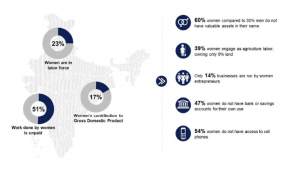
Source: Invest India Blog
The macroeconomic parameters for females have steadily declined.
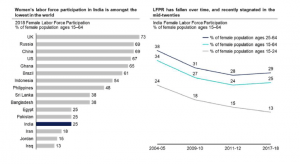
Source: Invest India Blog
2. Objectives of the Study:
The objective of this study is to furnish the significance of women’s education, the problem faced in educating women, causes of low literacy among females, women’s participation, steps taken by the government for promoting women’s education, merits, and recommendations for promoting women’s education. Finally, a conclusion is provided.
3. Data and Sources:
This study is having a descriptive research design. This study uses the Population Census of India, Cry.org downloads, Care India downloads, World Bank Databases, Unified District Information System for Education, and Annual Status of Education Reports of a different time. This study takes 2001 and 2011 for census data. Secondary data is used in this study.
4. Significance of Women’s Education:
Historically, women took part in all fields of life with full energy and enthusiasm. Indian mythology is evidenced by tales of highly educated women. One can find the historical proofs of ancient Indian education to the third century B.C. when education was provided orally and many women scholars were part of When there was the spread of Buddhism in India, some world-famous educational institutions like Nalanda, Vikramshila, and Takshila were formed. A large number of females were enrolled in these temples of learning as given by researchers. These temples of learning flourished from about the fifth century to the thirteenth century. The Muslim rulers established universities in Delhi, Lucknow, and Allahabad in the eleventh century. Even though education has been seen to be limited to certain sections of society. Provision of education for everyone is a difficult task.
Women are the backbone of any nation. Without the contribution of women, no nation can lead to the path of progress and prosperity. The very existence of humankind is because of women. Some important thoughts regarding the importance of women’s education are given below:
Swami Vivekananda said that women’s education is a thermometer to the progress of a country. He considered men and women as two wings of a bird, and a bird can’t fly with only one wing. So, according to him, there is no possibility for the welfare of the world unless the condition of women is improved. The education of women is not an option for development but mandatory for the progress of the nation.
Educate the women first and leave them to themselves, what reforms are needed for them and society at large.
Women must be given the freedom to solve their problems as per their rationality and convenience. No other person ought to interfere with this. Our Indian women are so strong and logical enough to make proper decisions in their best interests as other female counterparts do in the rest of the world.
M. Phule said that education is that which demonstrates the difference between what is good and what is evil.
Mahatma Gandhi said that to designate a woman with a delicate gender is progressive; it is man’s inequality and unfairness for women. If strength is described as a moral power, then the woman is superior to males which can be defined and expressed.
Ban-Ki-Moon, Secretary-General, United Nations said that there is no more valuable investment than in a girls’ education.
Jawaharlal Nehru said if we educate a man we educate a person, however, if we educate a female we educate a home. Women empowerment implies mother India will get empowered.
President Pranab Mukherjee said that empowerment of women can be expected only through the spread of education among women, encouragement of economic independence, and provision of opportunities that make them enable to furnish their talent, potential, and productivity.
APJ Abdul Kalam said that he asked the students to take an oath that they will work in their life to change the lives of at least 100 women by empowering them through education in different fields of life. The empowerment of women brings prosperity to a family, a society, and a nation in the end. When the female is happy, the family is happy. When the family is happy, society is happy. When society is happy, the state is happy and when the state is happy, there will be peace and prosperity in the country, and it will create a larger pace. It will have ripple effects.
Malala Yousufzai said that she doesn’t mind if she has to sit on the floor at school. All she wants is an education and she is not afraid of anyone.
Education of women not only helps in the development of human resources but also helps in increasing the quality of life within the home and outside. Education is the panacea of solving all problems in the country, then it will not be improper. Education provides a modification of behavior in every aspect of life whether its outlook, attitude, and mentality of people. Educated women not only promote education among their baby girl child but also can give and offer better guidance and choices to all their children. Educated women can also contribute to reducing infant mortality rate and growth rate of population.
There are several examples where the explicit role of education in the empowerment of women is depicted. In many parts of India, it is typical for girls to be pressured into marriage by their parents, irrespective of their desire to pursue higher education and work.
Few people defy prejudices, have the bravery to say “No”, and accomplish things in their very own time.
- Sanju Rani Verma, a Meerut inhabitant, preferred to seek her career ambitions despite marriage. After her mother died in 2018, Sanju, 28 years old, opted to flee her home. She was enrolled in her Postgraduate program with Delhi University at the time. Sanju’s family began urging her to marry, but she refused to surrender to her goals. She attempted unsuccessfully to persuade her family of the significance of education and a job. She didn’t have a choice but to depart her house. She aspired to become a divisional magistrate by passing the civil service examinations. She cracked UPPSC 2018. The 35-year-old still wanted to provide for her family financially, and she believed that those who formerly scorned her choices would now appreciate her as she progressed in her career as a government official. She also felt that families should trust in their daughters rather than confine them to the marriage oath.
- Asha Kandara, a former woman janitor for the Jodhpur Municipal Corporation, passed the Rajasthan Administrative Service test and is presently a deputy collector. In 1997, Asha married, although the marriage was shallow. She divorced her partner eight years ago and raised her 2 kids on her alone while also finishing her studies. In 2018, the 40-year-old attempted the civil service examination. Unfortunately, owing to the COVID-19 outbreak, the results were late, and she was compelled to seek another source of income to earn a living. She started working for the municipal corporation as a janitor. All of her work and effort rewarded off when the results were declared. Even though society insulted her for being a single mother and working as a janitor, Asha would use it as encouragement. She strived hard to accomplish all of her ambitions, exhibiting that none of these difficulties stopped in her path of accomplishing.
- Flight Lieutenant Gunjan Saxena, also famous as Kargil Girl, was the first female officer in the Indian Air Force to participate in warfare. Women were not allowed to go to combat areas or fly fighter planes during all those times. In 1994, Flight Lieutenant Gunjan Saxena and 25 other women student pilots were appointed for the Indian Air Force. It would be the first squad of female student pilots in the IAF. Gunjan Saxena later made history by becoming a flight lieutenant in the Indian Air Force during the 1999 Kargil War. She piloted a Cheetah chopper in a combat zone during that time and saved the lives of several Indian soldiers. She created headlines during that times and set an example for upcoming generations by doing so.
- Seema Kushwaha, the lawyer who secured Nirbhaya’s justice, is regarded as a bastion of strong law rather than as a lawyer. Her father was a farmer who lived in Uggarpur hamlet in Etawah, UP. She finished eighth grade. Additional education was forbidden. Girls were not well educated in the era. Her father, on the other hand, determined that she would be educated. Seema was about to graduate when he died. Her aunt funded her college expenses by selling her gold jewelry and anklets since she didn’t have enough money to pay. Seema has matured into a tough lady, a skilled advocate, and a prominent voice for women by somehow completed her studies by teaching tuitions.
- Ummul Kher, an IAS employee who was born and raised in a shanty in Delhi, has proven to be a fighter in her own right. This peanut seller’s daughter was brought up in a slum. Ummul Kher’s father used to sell items by the side of the road using a cart. Her shanty was destroyed in 2001, and she began to teach lessons in a leased house. She became the family’s only income that used these tuitions to finance her education as well. Ummul Kher’s life was complicated by the fact that she was born with a bone-frail illness that required her to have her bones calculated 16 times and have eight operations. Despite all of this, she became a top student in the 10th and 12th grades through teaching tuitions. She then started preparing for the JRF and UPSC examinations. She nailed the UPSC test with a 420th-place result on her first effort. She is an Assistant Commissioner, serving the country and mankind.
- Laxmi Agarwal has survived an acid assault. Laxmi is from Delhi and belongs to a middle-class house. Lakshmi aspired to be a singer, but an injury when she was young destroyed her life permanently. Lakshmi was 15 years old at the time, and a 32-year-old male intended to marry her. He splashed acid on Laxmi in 2005 after she refused to marry the young guy. When the acid was thrown at her, it seemed as if someone had lit her entire body on fire, she claimed just after the event. In response, she filed a petition with the Supreme Court in 2006, requesting that the acid must be abolished. Laxmi is an advocate for acid attack victims. She is presently the CEO of Stop Cell Acid, a company she established. This is anti-acid violence and anti-acid sales campaign. For her campaign Stop Cell Acid, Laxmi was also awarded the International Women Empowerment Award 2019 by the Ministry of Women and Child Development, the Ministry of Drinking Water and Sanitation, and UNICEF. She was also honored by US First Lady Michelle Obama with the 2014 International Women of Honor Award. She is now a pretty well-known personality.
- Arunima Sinha, the accident survivor, has been the first Indian woman to summit Mount Everest with a disability. Arunima, who was born in Sultanpur, Uttar Pradesh, has always been good at sports and was a national volleyball player. Arunima’s life was forever affected by an accident. She was traveling from Lucknow to Delhi in 2011 when she was flung from a speeding train, resulting in the amputation of her left leg. Arunima Sinha, who had her leg amputated, screamed in anguish the whole night. For four months, she struggled for her life in the hospital. She rebounded back with double the strength after receiving an artificial limb. Arunima kept her confidence and resolved to conquer Mount Everest, which she achieved successfully. She made a goal after conquering Everest to climb the highest peaks on each of the world’s seven continents. She has waved the tricolor atop Kilimanjaro: To Africa’s Roof and Mountain Elbrus in Europe so far in this sequence.
5. Problems in Women’s Education:
Gender discrimination is the topmost reason in the path of educating women. Women are considered the housewife only who needs to know “chulha-chokha” and serve as a “male child producing machine”. They are supposed to live within the four walls of houses only. The difference between the male-female literacy rate is an indicator that gives proof for it. Going outside for education makes females a vulnerable situation because their honor at any time can be violated by local people or rogue. The main hurdles in the path of education to women are sociological, gender categorization, and gender inequality. Economic barriers are also playing an essential role in education for women. The result of the characterization of gender and categorization is that women tend to engage and cooperate in programs that focus on their household work (Nair, 2010).
The culture of India, which has historically been a male-dominated civilization, casts females in a subservient position. The majority of the time, girls from the lower and middle sections have limited rights to be educated, while impoverished girls from distant areas in the nation are completely excluded. Apart from the financial expenditures of higher education, the security of girls from sexual misconduct is another threat to be addressed, for which the majority of girls’ parents are not mentally prepared. Approximately 80 females at a public school in Rewari, Haryana, embarked on unending fasting on May 10th.
They asked that their elementary school be converted to a high school. This is because they couldn’t go to the neighboring school, which was three km apart, leading to a shortage of mobility and sexual assault they encountered along the way. The girls kept their fast going, and after ten days, the state administration relented, allowing the rural school to add classes 11 and 12. However, the Rewari teen girls’ protest has implications beyond Haryana. It reminds us of a few key components of education in our country that are all too often neglected and unaddressed, even as the administration brags about mantras like Beti Bachao, Beti Padhao. Between such platitudes and the reality on the ground, there is a huge gulf. One truth, as demonstrated by the Rewari girls’ plea, is the issue of privacy. Women would like to learn further, but neither they nor their families are certain that they will be bullied or molested if they go to the neighboring higher secondary. If we want to increase female participation in higher secondary, we must deal with this issue. (EPW, 2017).
Other important limitations that impede women’s economic aspirations in India involve their undervalued socioeconomic role, lack of basic amenities, knowledge, abilities, investments, and finance and insurance, and gender-biased prejudicial social conventions. Because all of the government’s ministries are essential players in building a viable model for women’s economic empowerment in the country, these challenges and data necessitate a coordinated call to action from all of them.
6. Data on Girls’ Education that Should Be Considered:
Literacy Rates in India (1951-2011)
| Year | Males | Females | Male-Female
Gap in Literacy Rate |
| 1951 | 27.16 | 8.86 | 18.30 |
| 1961 | 40.40 | 15.35 | 25.05 |
| 1971 | 45.96 | 21.97 | 23.98 |
| 1981 | 56.38 | 29.76 | 26.62 |
| 1991 | 64.13 | 39.29 | 24.84 |
| 2001 | 75.26 | 53.67 | 21.59 |
| 2011 | 82.14 | 65.46 | 16.68 |
Source: Population Census of India (*Literacy rate for 1951 relates to population aged 5 years and above.)
Gender wise Literacy rate
| Rural | Urban | Total | ||||
| India | Male | Female | Male | Female | Male | Female |
| 2001 | 70.70 | 46.13 | 86.27 | 72.86 | 75.26 | 53.67 |
| 2011 | 77.15 | 57.93 | 88.76 | 79.11 | 82.14 | 65.46 |
Source: Census of India (2001 and 2011)
In secondary and higher secondary schools, there seem to be lesser girls:
* In India, an estimated 1.6 million females are often out of school. According to NCPCR (2018), 39.4 percent of females between the ages of 15 and 18 seem to be out of school (FP Staff, 2018).
* But by 11th grade, 57 percent of girls had dropped out (Kaushik, H., 2018).
* The distance to school is a big stumbling block: In rural India, there were only fourteen secondary (classes IX-X) and six higher secondary (classes XI-XII) schools for every hundred primary schools (classes I to VIII) {Annual Status of Education Report 2015-16}
Girls’ education in the SC, ST, and Muslim communities: SC and ST ladies’ participation in secondary and senior secondary schools is massively reduced:
SC girls participate at a rate of 19.34 basis points in primary school, 18.6 basis points in secondary education, and 17.3 basis points in higher secondary school.
It’s even worse for ST girls, with 10.35 basis points in primary school, 8.6 basis points in middle school, and 6.8 basis points in higher secondary school.
In terms of access to private schools, there is also a substantial gender divide: At the primary school level, more girls attend government schools (75 basis points at the primary level and 77.3 basis points at the upper secondary schools), while 19.2 basis points of all girls attend private schools (at the primary school level, 15.6 basis points at the upper secondary schools, and nearly the same at the higher secondary level) {Unified District Information System for Education (UDISE:2016-2017).
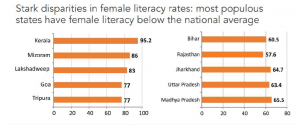
Infrastructural impediments exist for girls:
- Hygiene amenities (washrooms, potable water, and basic hygiene amenities) are present in 54 percent of schools (UDISE: 2017-2018).
- A boundary wall is absent in 35 basis points of schools (UDISE: 2017-2018).
- Women instructors are underrepresented in 16.6 basis points of secondary schools in the country (UDISE: 2016-2017).
- Women instructors account for 42.9 basis points of total teachers (UDISE: 2017-2018).
More females are dropping out of school: Even today, in India’s generation of children under the age of 15, more females (3.2%) are out of school than boys (2.7).
COVID-19 has a greater impact on girls: The epidemic is expected to cause over 10 million secondary school girls in India to drop out, placing them in danger of early marriage, childbearing, destitution, prostitution, and assault (Rodriguez, L., 2020).
In fundamental mathematics, girls fall behind boys: There is a gender disparity in fundamental mathematical abilities in the 14-16 age category. In India, 50.1 percent of males in the 14-16 age bracket can perform a divide. The statistic for girls is 44.1 percent (Annual Status of Education Report, 2018). 25% of young adults of 14 and 18 are unable to read a simple text proficiently in their tongue (Annual Status of Education Report, 2017).
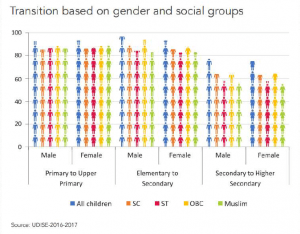
7. Main Causes for Low Literacy Rate Among Women: Despite many planned efforts by the government and rational outlook and understanding, the gap between male and female literacy still depicts worse figures. There are many prominent reasons behind this gap. Some are listed below:
- Social Discrimination
- Economic Exploitation
- A girl child is considered a liability who is meant to marry and will not contribute to economic and social development.
- Perception towards girl child to contribute to domestic work only.
- No decision-making authority at homes.
- Low enrolment ratio in schools
- Low retention rate and high drop rates
- Lack of women faculties in schools
- Schools establishment at distant places
- The female character portrays as a weak and helpless person in the curriculum which promotes gender discrimination.
- Security issues
- Inadequate sanitary facilities in schools
The education of females is hampered by entrenched patriarchy and deep-seated gender prejudices in society. Socially destructive social norms impose an economic burden of care on girls parenting for children, and domestic chores are invariably viewed as their obligation. Chauvinistic social conventions such as early marriage, dowry, and prohibitions on females’ migration operate as impediments to their schooling. Genital mutilation is greatest in India, and prejudice perpetuates in the form of inadequate nourishment, female assault, and child marriages (Down to Earth, 2018).
Girls are frequently subjected to a variety of security concerns at school, including taunting on the way to school, aggression, and assault, including internet abuse in school, gender based violence (GBV), and other forms of discrimination. The situation is exacerbated by a lack of secondary school options. Because of the scarcity of high education, females must travel hundreds of miles to pursue higher education, enhancing the likelihood of sexual harassment and kidnapping, and deterring families from sending their daughters to school. Because patriarchy intensifies biased tactics entrenched in bigotry against underprivileged communities, women suffer almost as much, both as girls and as members of disadvantaged tribes. Numerous findings demonstrate how gender expectations and prejudice are reinforced in schools when traditional roles are allocated. Unfair behaviors such as washing restrooms and assigning spaces based on caste, ethnicity, or creed are frequent and are frequently included in the curriculum. For females with disabilities or representatives of the Gay and lesbian community, discrimination develops. Teachers are not trained or sensitive to the needs of LGBTQ students, and instead of taking a strong stance against harassment, they are very often participating in it (Knight, K., 2019).
Concerns such as availability of appropriate infrastructure, lower academic quality, a dearth of female instructors, inadequate links to upper primary schools, a scarcity of educated teachers, and a syllabus that is not gender-responsive frequently force girls to drop out or fail to achieve their goals. Lack of separate working bathrooms for females, as well as a lack of appropriate infrastructure, puts girls at an even greater risk. Girls are sometimes forced to stay at home due to a lack of menstruation awareness, as well as a quasi-school infrastructure and a shortage of sanitary products (Sivakami, M. et al., 2018)
The education budget has been slashed repeatedly throughout the years, notably after 2014. It still accounts for 3.4 percent of the country’s GDP. In 2018-19, even targeted initiatives like Beti Bachao Beti Padhao, which aims to promote knowledge and promoting social assistance for girls, spent over 60% of its budget on advertisements (Outlook Web Bureau, 2019).
Additionally, a greater focus has been placed on learning and distance education, which might put girls at a barrier owing to the digital divide. Only 12.8 percent of all women can use a desktop, 14.9 percent can use the web, and only 12.5 percent of women have used the online services in the last 30 days. Rural regions are far worse. [7%, 8.5%, and 6.6%] respectively (NSSO, 2017-2018). During the COVID-19 debacle, this was discovered to be exacerbating educational disparities.
8. Women’s Participation: Women’s participation was visible on many platforms like Panchayati Raj. It means that all activities depict the women’s participation in the processes and administrative parts like formulation of policies, implementation, and evaluation of policies. Since pre-independence time, Indian women have been involved in politics. Article 15 of the Indian constitution assured equality to women under the law at the independence time. Women still have little representation in the political arena. There is a lack of power in the women’s hands of the center as well as states. About half of India’s population has only ten percent representation in the Lok Sabha. There are 21 women out of 233 MPs in the Rajya Sabha. All the sectors are dominated by males whether it is parliament, army, police, judiciary, railways, and engineering. Despite having provisions in the Indian Constitution, India was not able to attain morals like social justice, fairness, and equality. When the United Nations declared International Women’s Day in 1975, it raised women’s participation in politics all over the world. United Nations declared 1976 – 1985 as a decade for women which mainly focused on Equality, Development, and Peace.
In 1993, the 73rd and 74th Amendments to the constitution of India have made a provision for reservation of seats in the local bodies of panchayats and Municipalities for women, build a firm base for their involvement in decision making at the local level.
More girls get enrolled in schools than it was before 70 years. According to Unified-District Information System for Education (UDISE) 2015-16, the Gross Enrolment Ratio (GER) of girls at the secondary level is 80.97% and at the Senior Secondary level is 56.41% respectively. Regarding health, the mortality rate has come down. The gender gap has shown visible reduction and women started appearing on the political front and corporate sectors. Despite the social progress made by women, however, challenges exist. The Labour force participation rate among women in the rural area has reduced from 42.5 percent to 18 percent in 1987-88 and 2011-12 respectively. In an urban area, it has from 25.4 percent to 13.4 percent in the same period. According to the Economic Survey of 2017-18, women’s participation in the labor force declined to 25.3% and it was 33.1% as per the Economic Survey of 2011-12. To attain faster economic growth and utilize full capacity, the country needs to attain gender equality and inclusive growth. India is the fastest-growing economies in the world but it appears to achieve that minus its women population.
The Economic Survey provides many causes for falling women participation. First, the popularity of higher education in females leads to a reduction of the labor force in the labor market. Second, as the wage rate tends to increase, women are expected to focus on their home routine work rather than on earning. Third, lesser job chances, pay the difference based on gender discrimination and care of children and old aged people are some of the main reasons. To increase women’s participation in the labor market, there is a need to launch maternal leave for 26 weeks, equal pay for equal work policy strictly, and daycare centers for infants. Only legislative reforms and policy formulation can only do in this regard. The need of the hour is to alter attitudes, thinking, and cultural barriers that offer a path for empowerment to women.
Every decade, the Indian economy is booming, and startups are proving to be the engines propelling the development. Despite being the world’s third-largest startup nation with over 27,000 ventures, India’s female startups comprise just 5% of the total. Various characteristics, such as gender, age, and socioeconomic position, impact the risk-return ratio of becoming an entrepreneur. Male and female entrepreneurs have quite a different risk and return evaluation criteria. Women entrepreneurs face additional dangers of societal stigma and familial isolation when pursuing their company ideas, therefore this ratio can be significantly skewed. As a consequence, becoming an employer for a female is frequently less gratifying. Nevertheless, owing to targeted initiatives made by many players, the notion of incentives for women has altered in recent years.
9. Steps taken by the Government: There are many steps taken by the government for the empowerment of women. Below are some:
Mahila Samakhya Programme: This program was started in 1988 as a repercussion of the New Education Policy (1968). The main objective of this program was to empower females of rural areas especially socially and economically marginalized groups.
Sarva Shiksha Abhiyan (SSA): This program was started in 2001 by the Indian government whose main aim is to attain universal elementary education in a prescribed time scheduled as provided by the 86th Amendment of the Indian Constitution. To provide compulsory and free education to children of the age group lies between 6 to 14 years as a fundamental right.
Kasturba Gandhi Balika Vidyalaya Scheme(KGBV): This scheme was launched in July 2004, to provide education to girls at the primary level. It is for the rural areas where the literacy rate for females was very low. 100 percent reservation was allowed in those schools set up by the government where 75 percent was given to backward classes and 25 percent was given to those female members who belonged below the poverty line.
National Programme for Education of Girls (Elementary Level): This step was taken by the government in July 2003. In this NPEG, model educational institutes were started whose main objective was to provide fair chances for girls’ education. It was a matter of great achievement when the two girls scored attained to top 10 ranks of the entrance exam to the Indian Institutes of Technology (IITs) in the year 2013.
Beti Bacho Beti Padho (BBBP): This was started in 2015 on the flagship central government program in Panipat, Haryana. This program is promoting general awareness and improves the efficiency of welfare services specially meant for girls in India. It aims to save the girl child, educate the girl child for the better progress of the country.
Women did not start attending colleges the same as male counterparts until as recently as 1980. Education is something women today often take for granted and they do not think about all of the hard work it took to attain the right to education. In the past, Less-educated women often believed that they were incapable of participating in politics, having a career, or even owning property. Women who have received a quality education were more likely to be pioneers in civic activism.
Startup India provides at least one woman for each bank branch in the country with a bank loan between INR 10 lakh and 1 crore to start a virgin enterprise. This company might be in the manufacturing, service, or trading fields. In the event of non-individual firms, an SC/ST or a female investor requires a minimum of 51 percent of the ownership and majority ownership.
Rashtriya Mahila Kosh offers a wide range of credit solutions to help women to develop money and assets. One of their initiatives aims at giving loans to new and smaller businesses getting at least six months of savings and credit experience. Under this policy, a firm can also get a maximum loan of INR 10 lakhs to start up.
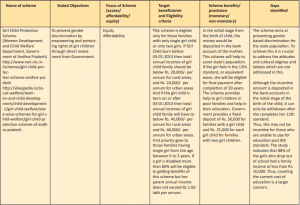
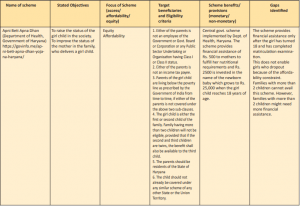
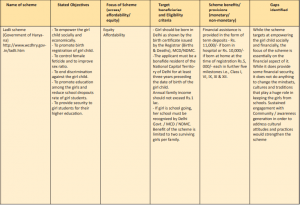
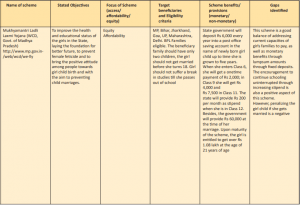
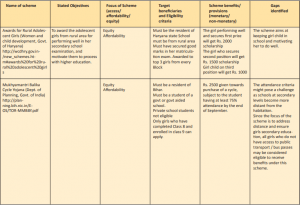
Source: https://www.cry.org/downloads/education/Educating_The_Girl_Child.pdf
10. Merits of Women’s Education: Gender Equality; Economic Productivity; Improved living standards; Strengthening of democracy; Social Improvement; Fall in infant mortality; Rationality in decision making; Knowing about their rights Recommendations to Promote Women’s Education: Efforts to change parents’ attitude towards women’s education; Removal of gender discrimination in the syllabus provided by the schools; Beti Bachao, Beti Padhao; Promoting higher education of women; Ensure a secured environment so that more parents can become convinced about women’s education.
Women’s empowerment programs have been implemented by a plethora of ministries, including Women and Child Development, Health and Family Welfare, Education, Rural Development, Skill Development and Entrepreneurship, Social Justice and Empowerment, and Finance, to mention a few. A comprehensive strategy will aid in the advancement of the system for gender-inclusive policymaking by applying different departments. This can enable keep women’s participation at the center of political debate and reduce the complexity of initiatives to accomplish similar or slightly equivalent goals.
Women must receive an education since it is their right and basic privilege.
- Education is a guaranteed strategy that provides them a significant degree of autonomy of allowing them to make meaningful decisions about the types of lives they would like to live (UNICEF, 2020).
- Educated females will have the abilities, expertise, and self-assurance to be good employees, voters, and mothers (UNICEF, 2020).
- Women’s livelihoods are revolutionized by learning; they are healthier, better supported, encounter less bias, make choices, and have authority over their productive and reproductive lives (Central Asia Institute).
- Education empowers females to take on management positions in their communities and the nation.
11. Conclusion:
Women play an essential role in approaching the country towards the path of development and progress. It is not possible to attain India’s pride and honor unless education among women is promoted. There are bleak chances for developing the world unless women will be empowered. The government of India should give main focus on women’s empowerment. Education of women will reduce inequalities and bring equality and social justification for the growth and prosperity of the country. The gender gap will be curtailed by promoting women’s education. No doubt, this gender gap is gradually getting reduced but still, the female illiteracy rate is 35%, as per the population census of India of 2011. Though the discrimination between males and females is reduced very fast unfortunately it is only in papers practically, the women are suffering the same as they did in the past ages. The need of the hour is to change the mindset of society especially the male members of families. Elderly females too change their perception towards their younger female parts. There is a need to inculcate the culture of respecting women in their homes itself from the child when they are born. They have to think liberally about their counterparts. Many targets and objectives can be fulfilled with the accomplishment of promoting women’s education.
References:
- Annual Status of Education Report 2015-16
- Annual Status of Education Report 2017
- Annual Status of Education Report 2018
- A. Subangini Devi (2014), A Study on Women’ Education in India, International Journal of Science, Technology and Humanities, 1, 105-110,
- Bhat, R. A., (2015), Role of Education in the Empowerment of Women in India, Journal of Education and Practice, 6(10), 188-191.
- Census of India 2001 and 2011, Government of India.
- Constitution of India, Article 21 A, Article 15(1) (13).
- Central Asia Institute. The Top 10 Reasons to Support Girls’ Education.
https://centralasiainstitute.org/top-10-reasons-tosupport-girls-education/ - Down to Earth. (2018, September 19). India witnesses one of the highest female
infanticide incidents in the world: study.
https://www.downtoearth.org.in/news/health/india-witnessesone-of-the-highest-femaleinfanticide-
incidents-in-theworld-54803 - FP Staff. (2018, February 5). Nearly 40% Adolescent Girls in India Lack Access to
Education, Majority Forced to Stay at Home: NCPCR report. First Post.
https://www.firstpost.com/India/nearly-40-adolescent-girls-in-India-lack-accesstoeducation-
majority-forced-to-stay-at-home-ncpcrreport-4335903.html - Hashemi, Syed M., and Schuler, Sidney Ruth and Riley, Ann P. (1996). Rural Credit
Programs and Women’s Empowerment in Bangladesh, World Development, Elsevier, Vol.
24(4), pp.635-653, April. - Knight, K. (2019, June 24). Section 377 is History but Young LGBT Indians Need
Concrete Policies to Protect them from Bullying.
https://www.hrw.org/news/2019/06/24/section-377- history-young-lgbt-indians-needconcrete-
policies-protectthem-bullying - Kaushik, H. (2018, December 2). 57% of Girl Students Drop out of Schools by Class
XI: Report.
Times of India. https://timesofindia.indiatimes.com/city/ ahmedabad/57-of-girl-studentsdrop-out-of-schools-by-classxi-report/articleshow/66900622.cms - Nisha Nair. (2010). Women’s Education in India: A Situational Analysis. IMJ, 1(4),
100-114. - Nithiya, P. (2012), Swami Vivekananda’s Views on Philosophy of Education, Asian
Journal of Multidimensional Research, Vol.1 Issue 6, November 2012, ISSN 2278-4853. - Outlook Web Bureau. (2019, January 22). 56% Of ‘Beti Bachao, Beti Padhao’ Funds
Spent On Advertisements: Minister. Outlook India. https://www.outlookindia.com/website/story/india-news-beti-bachao-beti-padhao-centrespent-56-of-funds-on-publicityminister-tells-lok-sabha/324035 - Rani, G. S. (2010), Women’s Education in India – An Analysis, Asia-Pacific Journal
of Social Sciences, 1, 106-124 - Rao, R. K. (2004), Women and Education, Kalpaz Publication, Delhi.
- Rodriguez, L. (2020, July 14). COVID-19 Is Undoing 70 Years of Girls’ Education Progress in India. Global Citizen https://www.globalcitizen.org/en/content/covid-19-impact-india-girlseducation/
- Roy, S. D. (2001), Education in The Vision of Swami Vivekananda.
- Sivakami, M. et al. (2018, December 7). Effect of menstruation on girls and their schooling, and facilitators of menstrual hygiene management in schools: surveys in government schools in three states in India, 2015. Journal of Global Health. Doi: 10.7189/jogh.09.010408
- UN Women 2018 Fact Sheet on India, World Bank Database
- Unified District Information System for Education (UDISE): 2017-2018.
- Unified District Information System for Education (UDISE): 2017-2018.
- Unified District Information System for Education (UDISE): 2016-2017.
- Unified District Information System for Education (UDISE): 2017-2018.
- UNICEF (2020). Girls Education: A Lifeline to Development. Retrieved on December
20, 2020, from: https://www.unicef. org/sowc96/ngirls.html - World Bank Database, Ministry of Statistics and Programme Implementation (MoSPI), ILO
- https://www.mckinsey.com/featured-insights/employment-and-growth/howadvancing-womens-equality-can-add-12-trillion-to-global-growth
- https://www.mckinsey.com/featured-insights/employment-and-growth/the-power-ofparity-advancing-womens-equality-in-india
- https://newsable.asianetnews.com/gallery/india/international-day-of-the-girl-2020-10-women-who-are-examples-of-women-empowerment-vpn-qi0uua#image3
- https://www.cry.org/downloads/education/Educating_The_Girl_Child.pdf
- https://www.careindia.org/wp-content/uploads/2021/05/Policy-Brief-Girls-Education.pdf
Shubhi Agarwal, Ph.D. Scholar,
Dept. of Economics, Meerut College
Ch. Charan Singh University, Meerut
Rahul Agarwal, MSc,
Dept. of Maths, Kirori Mal College,
University of Delhi








